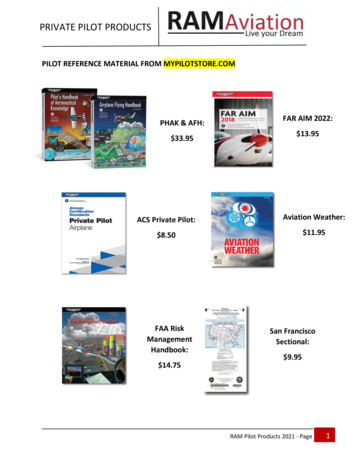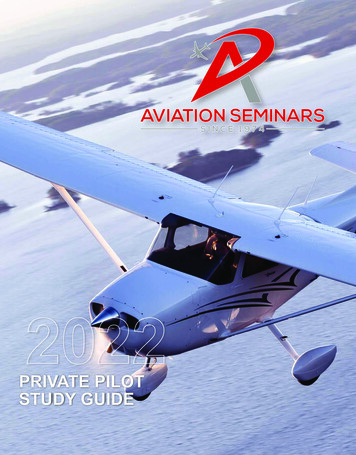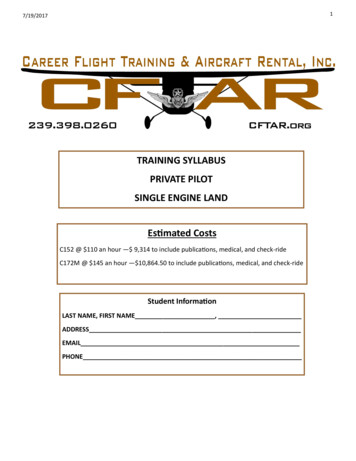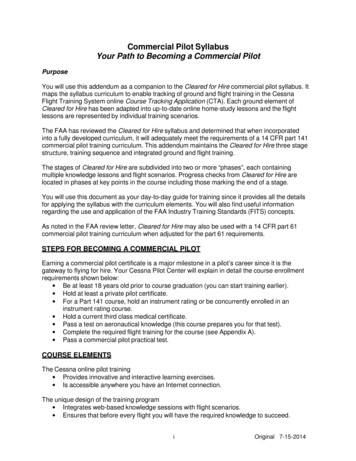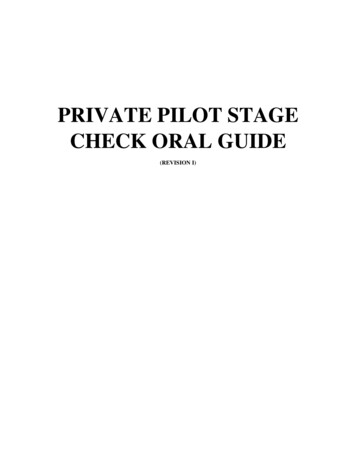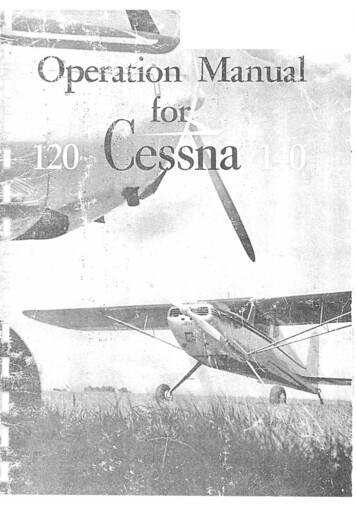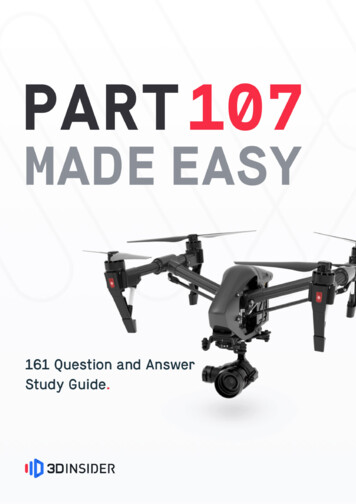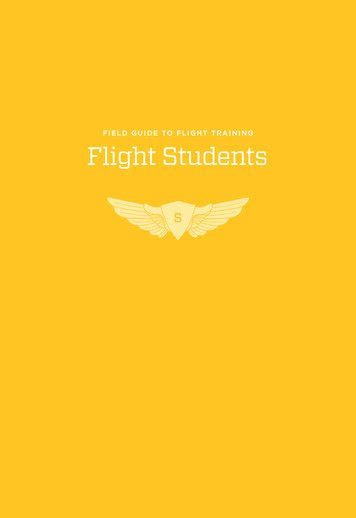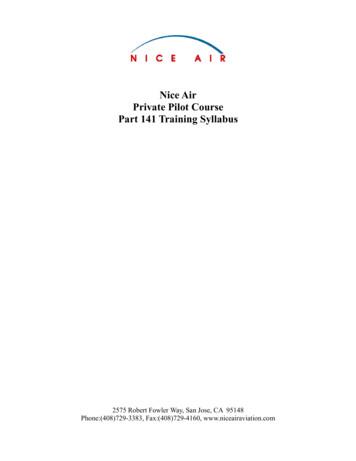
Transcription
Nice AirPrivate Pilot CoursePart 141 Training Syllabus2575 Robert Fowler Way, San Jose, CA 95148Phone:(408)729-3383, Fax:(408)729-4160, www.niceairaviation.com
Part 141 Private Pilot SyllabusLES S O N T IM E A LLO C A T IO NGROUNDSTAGE IGROUNDSTAGE IIGROUNDSTAGE III3.010.02.0TOTAL2.03.06.02.01.0As 02.01.01.01.02.01.02.0COURSE OVERVIEW-----FLIGHT TRAINING1.02.02.0FLIG H T T R A IN IN GD U untryCountryFLIG H TSATG E I10.5FLIG H TS T A G E II4.0FLIG H TS T A G E III6.0T O T A LS20.52.02.01.01.02.02.0S O LO1.0DayCrossDual/SoloLocal Country Com bined 0Note;Dualinstrum ent training in airplane is allocated to portion of flight lessons 3,4,5,7,8,14,15,19,and 20 for a totalof 3.0 hours.The m inim um recom m ended tim es are .2 hours(12m inutes) for Flight lesson 3,4,5,7,8 and .5 hours (30 m inutes) each for Flight lesson 14,15,19,and 20.The totalof 3.0 hours of instrum ent training is specified in Appendix B,Part 141.6.016.02.01.0G round stage I, II and Flight stage IGround lesson 1-Discovering aviationGround lesson 2-Airplane system s0.5Flight 1-Introduction to flightGround lesson 3-Aerodynam ic principles1.0Flight 2-Ground operationGround lesson 4-The flight environm ent1.5Flight 3-Basic m aneuvers & StallsGround lesson 5-Com m unication & Flightinfo.1.0Flight 4-Em ergency operationAsesson 6-Stage Iexamreq. Ground l1.0Flight 5-Ground reference m aneuversGround lesson 7-M eteorology for pilots2.0Flight 6-Airport operationsGround lesson 8-Federalaviationregulation1.0Flight 7-Ground reference m aneuversGround lesson 9-Interpreting weatherdataAso written exam and briefingreq. Pre-sol1.0Flight 8-ReviewAsesson 10-Stage IIexamreq. Ground l1.0Flight 9-Stage check0.5Flight 10-First soloAs10.5Stagetotalreq.Day cross-countryDay localSoloInstrum entNight cross-countryAs RequiredNight local1.0Day localExamDebriefingsExam debriefingStage/ FinalExamsStage/FinalexamPrivate PilotPrivate PilotManeuvers,Manual,ClassClassPilot BriefingsDiscussionDiscussion,Video and CD- and VideoROMFlight trainingDualPilot briefingGROUND TRAININGPrivate pilotm aneuvers , discussion,videoPrivate pilot m anual,class,discussion,videoGround trainingDay cross-countryCOURSE OVER VIEW--GROUND TRAINING0.20.20.20.20.20.51.00.5NO TE:1.The first colum n shows the recom m ended Private Pilot M aneuvers discussion,video,and/or CD-RO M training tim e.The third colum n shows the m inim um recom m ended trainingtim e for private Pilot M anualclass discussion,and video.Tim es shown in colum ns 1 m ay becredited toward the totaltim e shown in colum n 3 up to 9 hours of Private Pilot M aneuversclass discussion,video,and/or CD-RO M .
LES S O N T IM E A LLO C A T IO NLES S O N T IM E A LLO C A T IO NFlight trainingG round stage III and Flight stage IIGround lesson 11-Airplane perform anceFlight 11-Perform ance takeoffs and1.01.0landings2.0Ground lesson 12-Navigation1.0Flight 12-Second SoloGround lesson 13-Hum an factors2.0principles1.0Flight 13-Localarea solo2.0Ground lesson 14-Flying cross country1.01.00.5Flight 14-VO 5Flight 15-Dualinstrum ent1.0Flight 16-Dualnight1.02.00.5Flight 17-Dualcross-country2.02.0 0.5Flight 18-DualNight cross-country3.0 1.0 Ground lesson 16 & 17-Finalexam A & B1.0Flight 19-Stage CheckBriefing-Solo cross-country2.0Flight 20-Solo cross-countryAs3.08.02.0 4.04.0 2.0 1.0 2.0 2.0 2.0Stagetotalreq.NO TE:The first colum n shows the recom m ended Private Pilot M aneuvers discussion,video.The third colum n shows the m inim um recom m ended training tim e for private Pilot M anualclass discussion,and video.Tim es shown in colum ns 1 m ay be credited toward the totaltim eshown in colum n 3 up to 9 hours of Private Pilot M aneuvers class discussion,video.2.0Asreq.Flight stage IIIFlight 21-Solo Long cross-countryFlight 22-DualPTS preparationFlight 23-Solo PTS preparationFlight 24-DualPTS preparationFlight 25-Stage CheckBriefing-Private pilot practicaltestFlight 26-End-O f-Course checkStage totalDay cross-countryDay localSoloInstrum entNight cross-countryNight localDay cross-countryDay localExam debriefingStage/FinalexamPilot briefingDualPrivate pilot m aneuvers ,discussion,videoPrivate pilot m anual,class,discussion,videoDay cross-countrySoloInstrum entNight cross-countryNight localDay cross-countryDay localExam debriefingStage/FinalexamPilot briefingDualPrivate pilot m aneuvers ,discussion,videoPrivate pilot m anual,class,discussion,videoGround trainingFlight trainingDay localGround training3.02.02.02.01.01.06.02.03.0The individualtim es shown on the accom panying lesson tim e allocation tables are forinstructor/ student guidance only;they are not m andatory for each ground lesson,flightlesson or stage of training.At the end of this course,the student m ust m eet the m inim umrequirem ents of FAR part 14,appendix B for each category in order to graduate.Preflight andpost flight briefing tim e are not specified but m inim um of .5 hour for each dualor sololessons is suggested.The tim e for the pilot briefing,although assigned and com pleted alongwith selected flight lessons,are considered part of ground training.
PRIVATE PILOT SYLLABUSPrivate Pilot Certification CourseAirplane Single-Engine LandGround Training: 35 HoursGROUND TRAINING COURSE OBJECTIVESThe student will obtain the knowledge, skill, and aeronautical experience necessary to meetthe requirements for a private pilot certificate with an airplane category rating and a singleengine land class rating.GROUND TRAINING COURSE COMPLETION STANDARDSThe student must demonstrate through knowledge tests, flight tests, and show throughappropriate records that he / she meets the knowledge, skill, and experience requirementsnecessary to obtain a private pilot certificate with an airplane category rating and a singleengine land class rating.STAGE ISTAGE OBJECTIVESDuring this stage, the student will be introduced to pilot training, aviation opportunities,human factors in aviation, and become familiar with airplane systems and aerodynamicprinciples, as well as the flight environment. The student also will obtain a basic knowledgeof safety of flight, airports, aeronautical charts, airspace, radio communications, and airtraffic control services, including the use of radar. In addition, the student will learn radioprocedures and the common sources of flight information.STAGE COMPLETION STANDARDSThis stage is complete when the student has completed the Stage I written exam with aminimum passing score of 80%, and the instructor has reviewed each incorrect response toensure complete understanding before the student progresses to Stage II.
PRIVATE PILOT SYLLABUSSTAGE IGROUND LESSON 1LESSON REFERENCE:PRIVATE PILOT MANUALCHAPTER 1, Discovering Aviation Crew resource managementPilot-In Command responsibilityCommunicationResource useWorkload managementSituational awarenessAviation physiologyAlcohol, drugs and performanceFitness for flightRECOMENNDED SEQUENCE:NOTE: Students should read Chapter 1, Section A, B and C, prior to Ground Lesson 1.Lesson introductionClass discussionLESSON OBJECTIVES: Become familiar with pilot training, aviation opportunities, and human factors inaviation. Gain a basic understanding of a school's pilot training program.ACADEMIC CONTENT:SECTION A-PILOT TRAINING How to get startedRole of the FAAFixed-base operations (FBOs)Eligibility requirementTypes of training availablePhases of trainingPrivate pilot privileges and limitationsSECTION B- AVIATION OPPORTUNITIES New experiencesAviation organizationsCategory/Class ratingsAdditional pilot certificatesAviation careersSECTION C-INTRODUCTION TO HUMAN FACTORS Aeronautical decision makingSTUDY ASSIGNMENT:PRIVATE PILOT MANUALCHAPTER2, Airplane systemsCOMPLETIONSTANDARDS:The student willlindicate, thoughoral quizzing,familiarity withpilot trainingprograms,opportunities inaviation, andhuman factor. Inaddition, theinstructor willmake sure thestudent has abasicunderstanding ofpolicies andprocedureapplicable to theschool's pilottraining program.
PRIVATE PILOT SYLLABUSSTAGE IGROUND LESSONVIDEOPART I , CHAPTER 2RECOMENNDED SEQUENCE:1. Lesson Introduction and Video Presentation2. Class DiscussionLESSON OBJECTIVES: Gain a basic understanding of the main airplane components and systems. Become familiar with flight instrument functions and operating characteristics,including errors and common malfunctions. Learn about the power plant and related systems.ACADEMIC CONTENT:SECTION A-AIRPLANEFuselageWingsEmpennageLanding GearEngine/PropellerPilot's Operating Handbook (POH)SECTION B-THE POWER PLANT AND RELEATED SYSTEMS PropellersPropeller HazardsElectrical Systems2LESSON REFERENCE:PRIVATE PILOT MANUALCHAPTER 2, Airplane Systems Reciprocating EngineInduction SystemsSupercharging and Turbo chargingIgnition SystemsFuel SystemsRefuelingOil SystemsCooling SystemsExhaust SystemsSECTION C-FLIGHT INSTRUMENTS Pitot-Static InstrumentsAirspeed IndicatorAltimeterVertical Speed IndicatorGyroscopic InstrumentsMagnetic CompassSTUDY ASSIGNMENT:PRIVATE PILOT MANUALCHAPTER 3, Aerodynamic ding duringoral quizzing byinstructor atcompletion of lesson.Student completesChapter 2 questions forSections A, B, and Cwith a minimumpassing score of 80%.Instructor reviewsincorrect responses toensure studentunderstanding prior toprogression to GroundLesson 3.
PRIVATE PILOT SYLLABUSSTAGE IGROUND LESSON3LESSON REFERENCE:PRIVATE PILOT MANUALCHAPTER 3, Aerodynamic PrinciplesVIDEOPART I , CHAPTER 3RECOMENNDED SEQUENCE:1. Lesson Introduction and Video Presentation2. Class DiscussionLESSON OBJECTIVES: Become familiar with the four forces of flight, aerodynamic principles of stability,maneuvering flight, and load factor. Gain a basic understanding of stall/spin characteristics as they relate to trainingairplanes. Learn the importance of prompt recognition of stall indicationsACADEMIC CONTENT:SECTION A-FOUR FORCE OF FLIGHT LiftAirfoilsPilot Control of LiftWeightThrustDragGround EffectSECTION B-STABILITY Three Axes of FlightLongitudinal StabilityCenter of Gravity PositionLateral StabilityDirectional StabilityStallsSpinsSECTION C-AERODYNAMICS OF MANEUVERING FLIGHT Climbing FlightLeft-Turning TendenciesDescending FlightTurning FlightLoad FactorSTUDY ASSIGNMENT:PRIVATE PILOT MANUALCHAPTER 4, The Flight nding duringoral quizzing byinstructor atcompletion of lesson.Student completesChapter 3 questions forSections A, B, and Cwith a minimumpassing score of 80%.Instructor reviewsincorrect responses toensure completestudent understandingprior to progression toGround Lesson 4
PRIVATE PILOT SYLLABUSSTAGE IGROUND LESSON4LESSON REFERENCE:PRIVATE PILOT MANUALCHAPTER 4 The Flight EnvironmentVIDEOPART II , CHAPTER 4RECOMENNDED SEQUENCE:1.Lesson Introduction and Video Presentation2.Class DiscussionLESSON OBJECTIVES: Understand important safety considerations, including collision avoidancecautions, flight-of-way rules, and minimum safe altitudes. Become familiar with airport marking and lighting, aeronautical charts, and typesof airspace. Learn about collision avoidance procedures and runway incursion avoidance.ACADEMIC CONTENT:SECTION A -SAFETY OF FLIGHT Collision Avoidance/Visual Scanning Airport Operations Right-of-Way Rules Minimum Safe Altitudes Taxiing in Wind Positive Exchange of Flight ControlsSECTION B-AIRPORTS Controlled and UncontrolledRunway LayoutTraffic PatternAirport Visual AidsTaxiway MarkingsRamp Area Hand SignalsRunway Incursion AvoidanceLand and Hold Short Operations (LAHSO)Airport Lighting Visual Glideslope IndicatorsApproach Light SystemsPilot-Controlled LightingSECTION C-AERONAUTICAL CHARTS Latitude and LongitudeProjectionsSectional ChartsWorld Aeronautical ChartsChart SymbologySECTION D-AIRSPACE ClassificationsUncontrolled AirspaceControlled AirspaceClass EClass DClass CClass BClass ASpecial VFRSpecial Use AirspaceOther Airspace AreasEmergency Air Traffic RulesAir Defense Identification ZonesSTUDY ASSIGNMENT:PRIVATE PILOT MANUALCHAPTER 5, Communication and derstanding duringoral quizzing byinstructor atcompletion of lesson.Student completesChapter 4 questionsfor Sections A,B, C,and D with aminimum passingscore of 80%.Instructor reviewsincorrect responses toensure completestudent understandingprior to progression toground Lesson 5.
PRIVATE PILOT SYLLABUS STAGE IGROUND LESSON5LESSON REFERENCE:PRIVATE PILOT MANUALCHAPTER 5, Communication And Flight InformationsVIDEOPART II , CHAPTER 5RECOMENNDED SEQUENCE:1. Lesson Introduction and Video Presentation2. Class DiscussionLESSON OBJECTIVES: Become familiar with radar, transponder operations, and FAA radar equipment andservices for VFR aircraft. Understand the types of service provided by an F5S. Learn how to use the radio for communication. Gain a basic understanding of thesources of flight information, particularly the Aeronautical Information Manual andFAA advisory circulars.ACADEMIC CONTENT:SECTION A-RADAR AND ATC CERVICE RadarTransponder OperationFAA Radar SystemsVFR Radar ServicesAutomatic Terminal Information Service (ATIS)Flight Service StationsVHF Direction Finder AssistanceSECTION B-RADIO PROCEDURES VHF Communication EquipmentUsing the RadioPhonetic AlphabetCoordinated Universal TimeCommon Traffic Advisory Frequency (CTAF)ATC Facilities and Controlled AirportsLost Communication ProceduresEmergency ProceduresEmergency Locator Transmitters (ELTs)SECTION C-SOURCE OF FLIGHT INFORMATION Airport/Facility DirectoryFederal Aviation RegulationsAeronautical information Manual (AIM)Notices to Airmen (NOTAMs)Advisory CircularsSTUDY ASSIGNMENT:PRIVATE PILOT MANUALReview Chapters 2,3,4 and 5 in preparation forthe Stage I Exam.COMPLETIONSTANDARDS:Demonstrateunderstanding duringoral quizzing byinstructor atcompletion of lesson.Student completesChapter 6 questionfor Sections A, B, Cwith a minimumpassing score of80%. Instructorreviews incorrectresponses to ensurecompleteunderstanding priorto progression to theStage Exam inGround Lesson 6.
PRIVATE PILOT SYLLABUSSTAGE IGROUND LESSONSTAGE I EXAM6LESSON REFERENCE:PRIVATE PILOT MANUALCHAPTER 1 through 5,VIDEOPART I AND II , CHAPTER1- 5RECOMENNDED SEQUENCE:1. Lesson Introduction2. Testing3. CritiqueLESSON OBJECTIVES: Demonstrate comprehension of the material presented in Chapters 1through 5 of the Private Pilot Manual.ACADEMIC CONTENT:STAGE EXAM Airplane SystemsAerodynamic PrinciplesThe Flight EnvironmentCommunication and Flight InformationSTUDY ASSIGNMENT:PRIVATE PILOT MANUALReview Chapters 6, Meteorology for PilotCOMPLETIONSTANDARDS:This lesson andstage are completewhen the studenthas completed theStage 1 Exam withminimum of 80%,and the instructorhas reviewed eachincorrect response toensure completeunderstandingbefore the studentprogresses to StageII.
PRIVATE PILOT SYLLABUSSTAGE IISTAGE OBJECTIVESDuring this stage, the student will become familiar with weather theory, typical weatherpattern and aviation weather hazards. In addition to meteorological theory, the student willlearn how to obtain and interpret various weather reports, forecasts and graphic charts.Finally, the student will become thoroughly familiar with FAR as they apply to private pilotoperations.STAGE COMPLETION STANDARDSThis stage is complete when the student has completed the Stage II written exam with aminimum passing score of 80%, and the instructor has reviewed each incorrect response toensure complete understanding before the student progresses to Stage III.
PRIVATE PILOT SYLLABUSSTAGE IGROUND LESSON FrontsSECTION C-WEATHER HAZERDS7LESSON REFERENCE:PRIVATE PILOT MANUALCHAPTER 6, Meteorology for PilotVIDEOPART III , CHAPTER 6 ThunderstormsTurbulenceWake TurbulenceWind ShearMicroburstIcingRestrictions to VisibilityVolcanic AshSTUDY ASSIGNMENT:RECOMENNDED SEQUENCE:1. Lesson Introduction and Video PresentationFAR/ AIM2. Class DiscussionPrivate Pilot FARs, Recommended Study ListsLESSON OBJECTIVES: Learn the causes of various weather conditions, frontal systems, andhazardous weather phenomena. Understand how to recognize critical weather situations from the ground andduring flight, including hazards associated with thunderstorms. Become familiar with the recognition and avoidance of wind shear and waketurbulence.ACADEMIC CONTENT:SECTION A-BASIC WEATHER THEORY The AtmosphereAtmospheric CirculationAtmospheric PressureCoriolis ForceGlobal Wind PatternsLocal Wind PatternsSECTION B-WEATHER PATTERN Atmospheric StabilityTemperature InversionsMoistureHumidityDewpointClouds and strateunderstanding duringoral quizzing byinstructor atcompletion of lesson.Student completesChapter 6 questionfor Sections A, B, Cwith a minimumpassing score of80%. Instructorreviews incorrectresponses to ensurecompleteunderstanding priorto Ground Lesson 8.
PRIVATE PILOT SYLLABUSSTAGE IIGROUND LESSON8LESSON REFERENCE:FAR/AIMPrivate Pilot FARsFAR/AIM ManualPrivate Pilot FARsRECOMENNDED SEQUENCE:1. Lesson Introduction and Video Presentation2. Class DiscussionLESSON OBJECTIVES: Understand the appropriate Federal Aviation Regulations in the Private PilotRecommended Study List. Gain specific knowledge of those FARs which govern student solo flight operations,private pilot privileges, limitations, and National Transportation Safety Board(NTSB) accident reporting requirements.ACADEMIC CONTENT: FAR Part 1 FAR Part 61 FAR Part 91 NTSB 830STUDY ASSIGNMENT:Private Pilot ManualChapter 7, Interpreting Weather DataCOMPLETIONSTANDARDS:Demonstrateunderstanding duringoral quizzing byinstructor atcompletion of lesson.Student completesGround Lesson 8Private Pilot FARExercises with aminimum passingscore of 80%.Instructor reviewsincorrect responses toensure understandingprior to progressing toGround Lesson 9.
PRIVATE PILOT SYLLABUSSTAGE IIGROUND LESSON9LESSON REFERENCE:PRIVATE PILOT MANUALCHAPTER 7, Interpreting Weather DataVIDEOPART III , CHAPTER 7RECOMENNDED SEQUENCE:1.Lesson Introduction and Video Presentation2.Class DiscussionLESSON OBJECTIVES: Learn how to obtain and interpret weather reports, formats, and graphic charts. Become familiar with the sources of weather information during preflight planningand while in flight. Recognize critical weather situations described by weather reports and forecasts.ACADEMIC CONTENT:SECTION A -THE FORECASTING PROCESS Forecasting Methods Types of Forecasts Compiling and Processing Weather Data Forecasting Accuracy and LimitationsSECTION B-PRINTED REPORTS AND FORECASTS Aviation Routine Weather Report (METAR)Radar Weather ReportsPilot Weather ReportsTerminal Aerodrome Forecast (TAF)Aviation Area ForecastWinds and Temperatures Aloft ForecastSevere Weather Reports and ForecastsAIRMET/SIGMET/Convective SIGMETSECTION C-GRAPHIC REPORTS AND FORECASTS Surface Analysis ChartWeather Depiction Chart Radar Summary Chart Satellite Weather PicturesLow-Level Significant Weather ProgSevere Weather Outlook ChartForecast Winds and Temperatures Aloft ChartVolcanic Ash Forecast and Dispersion ChartSECTION D-SOURCE OF WEATHER INFORMATION Preflight Weather SourcesIn-Flight Weather SourcesEnroute Flight Advisory ServiceWeather Radar ServicesAutomated Weather Reporting SystemsSTUDY ASSIGNMENT:PRIVATE PILOT MANUALReview Chapters 6 and 7 and the FAR/AIM inpreparation for the Stage II Exam.COMPLETIONSTANDARDS:Demonstrateunderstanding duringoral quizzing byinstructor at thecompletion of lesson.Student completesChapter 7 questionsfor Section A, B, Cand D with aminimum passingscore of 80%.Instructor reviewsincorrect responses toensure completestudent understandingprior to progressing tothe Stage II Exam.
PRIVATE PILOT SYLLABUSSTAGE IIGROUND LESSONSTAGE II EXAM10LESSON REFERENCE:PRIVATE PILOT MANUALCHAPTER 6 and 7FAR/AIM-Private Pilot FARsVIDEOPART III , CHAPTER 6 and 7RECOMENNDED SEQUENCE:1. Lesson Introduction2. Testing3. CritiqueLESSON OBJECTIVES: Demonstrate comprehension of the material presented in Chapters 6 and 7 of thePrivate Pilot Manual and the FARs that apply to private pilot operations, includingprivate pilot privileges, limitations, and NTSB accident reporting requirements.ACADEMIC CONTENT:STAGE II EXAM Meteorology for PilotsFederal Aviation RegulationsInterpreting Weather DataSTUDY ASSIGNMENT:PRIVATE PILOT MANUALCHAPTER 8, Airplane PerformanceCOMPLETIONSTANDARDS:This lesson and stageare complete when thestudent has completedthe State II Exam witha minimum passingscore of 80%, and theinstructor has reviewedeach incorrect responseto ensure completeunderstanding beforethe student progressesto Stage III.
PRIVATE PILOT SYLLABUSSTAGE IIISTAGE OBJECTIVESDuring this stage, the student will learn how to predict performance and control the weightand balance condition of the airplane. In addition, the student will be introduced to pilotage,dead reckoning, and navigation equipment. This includes understanding the basic conceptsof how to use actual charts, potters, flight computers, and flight publications to plan crosscountry flight. The student will learn how to use VOR, ADF, and advanced navigationsystems. In addition, the student will obtain an understanding of the physiological factorswhich can affect both pilot and passengers during flight. Finally, the student will learn howto conduct comprehensive preflight planning for cross-country flights and gain insight intofactors affecting aeronautical decision making.STAGE COMPLETION STANDARDSThis stage is complete when the student has completed the Stage III written exam with aminimum passing score of 80%, and the instructor has reviewed each incorrect response toensure complete understanding .
PRIVATE PILOT SYLLABUSSTAGE IIIGROUND LESSON11LESSON REFERENCE:PRIVATE PILOT MANUALCHAPTER 8, Airplane PerformanceVIDEOPART IV , CHAPTER 8 Weight-Shift FormulaEffects of Operating at High Total WeightsFlight at Various CG PositionsECTION C-WEATHER HAZERDS Mechanical Flight ComputersTime, Speed, and DistanceAirspeed and Density Altitude ComputationsWind ProblemsConversionsMulti-Part ProblemsElectronic Flight ComputersModes and BasicOperationsRECOMENNDED SEQUENCE:STUDY ASSIGNMENT:1. Lesson Introduction and Video Presentation2. Class DiscussionPrivate pilot manualLESSON OBJECTIVES:CHAPTER 9, Navigation Learn how to use data supplied by the manufacturer to predict airplane performance,including takeoff and landing distances and fuel requirements. Learn to compute and control the weight and balance condition of a typical trainingairplane. Become familiar with basic functions of aviation computers. Understand the effectsof density altitude on takeoff and climb performance.ACADEMIC CONTENT:SECTION A-PREDICTING PERFORMANCE Aircraft Performance and DesignChart PresentationsFactors Affecting PerformanceTakeoff and Landing PerformanceClimb PerformanceCruise PerformanceUsing Performance ChartsSECTION B-WEIGHT AND BALANCE Importance of WeightImportance of BalanceTerminologyPrinciples of Weight and BalanceComputation MethodTable MethodGraph MethodCOMPLETIONSTANDARDS:Demonstrateunderstanding duringoral quizzing byinstructor atcompletion of eachlesson. Studentcompletes Chapter 8questions for SectionA, B and C with aminimum passingscore of 80%.Instructor reviewsincorrect answers toensure completeunderstanding prior toprogressing to Lesson12.
PRIVATE PILOT SYLLABUSSTAGE IIIGROUND LESSONSECTION C-ADF NAVIGATION12LESSON REFERENCE:PRIVATE PILOT MANUALCHAPTER 9, NavigationVIDEOPART IV , CHAPTER 9RECOMENNDED SEQUENCE:1. Lesson Introduction and Video Presentation2. Class DiscussionLESSON OBJECTIVES: Learn the basic concepts for VFR navigation using pilotage, dead reckoning, andaircraft navigation systems. Become familiar with guidelines and recommended procedures related to flightplanning, use of an FAA Right Plan, VFR cruising altitudes, and lost procedures. Gain a basic understanding of VFR navigation using pilotage, dead reckoning, andnavigation systems.ACADEMIC CONTENT:SECTION A-PILOTAGE AND DEAD RECKONING PilotageDead ReckoningRight PlanningVFR Cruising AltitudesFlight PlanLost ProceduresSECTION B-VOR NAVIGATION VOR OperationsGround and Airborne EquipmentBasic ProceduresVOR Orientation and NavigationVOR Checkpoints and Test SignalsVOR PrecautionsHorizontal Situation IndicatorDistance Measuring Equipment (DME) ADF EquipmentOrientationHomingADF Intercepts and TrackingMovable-Card IndicatorsRadio Magnetic IndicatorADF PrecautionsSECTION D-ADVANCED NAVIGATION VORTAC-Based Area NavigationInertial Navigation SystemGlobal Positioning SystemSTUDY ASSIGNMENT:Private pilot manualCHAPTER 10, Applying Human derstanding duringoral quizzing byinstructor atcompletion of lesson.Student completesChapter 9 questions forSections A, B, C and Dwith a minimumpassing score 80%.Instructor reviewsincorrect responses toensure completestudent understandingprior to progressing toGround Lesson 13.
PRIVATE PILOT SYLLABUS Applying Human Factors TrainingSTAGE IIIGROUND LESSON13LESSON REFERENCE:PRIVATE PILOT MANUALCHAPTER 10, Applying Human Factors PrinciplesVIDEOPART V , CHAPTER 10RECOMENNDED SEQUENCE:1. Lesson Introduction and Video Presentation2. Class DiscussionLESSON OBJECTIVES: Gain an insight into important aviation physiological factors as they relate to privatepilot operations. Become familiar with the accepted procedures and concepts pertaining toaeronautical decision making and judgment, including cockpit resource managementand human factors training. Gain a basic understanding of aeronautical decision making and judgment.ACADEMIC CONTENT:SECTION A-AVIATION PHYSIOLOGY Vision in FlightNight VisionVisual ilationSECTION B-AERONAUTICAL DECISION MAKING Applying the Decision Making ProcessPilot-in-Command ResponsibilityCommunicationWorkload ManagementSituational AwarenessResource UseSTUDY ASSIGNMENT:Private pilot manualCHAPTER 11, Flying tanding duringoral quizzing byinstructor atcompletion of lesson.Student completesfor Sections A, and Bwith a minimumpassing score of80%. Instructorreviews incorrectresponses to ensurecomplete studentunderstanding priorto progressing toGround Lesson 14.
PRIVATE PILOT SYLLABUSCOMPLETIONSTANDARDS:STAGE IIIGROUND LESSON14LESSON REFERENCE:PRIVATE PILOT MANUALCHAPTER 11, Flying Cross-CountryRECOMENNDED SEQUENCE:1. Lesson Introduction and Video Presentation2. Class DiscussionLESSON OBJECTIVES: Develop a sound understanding of the planning process for a cross-country flight. Become familiar with the details of flying a typical cross-country flight, includingevaluation of in-flight weather and decisions for alternative actions, such as adiversion. Understand how to plan for alternatives.ACADEMIC CONTENT:SECTION A-THE FLIGHT PLANNING PROCESS Developing the RoutePreflight Weather BriefingCompleting the Navigation LogFlight PlanPreflight InspectionSECTION B-THE FLIGHT Departure Reid-Hillview Airport to Stockton AirportStockton Airport to Hollister AirportHollister Airport to Reid-HillviewDiversion to San Jose International AirportReturn to Reid-Hillview AirportSTUDY ASSIGNMENT:Private pilot manualCHAPTER 8-11 in preparation for the StageIII ExamDemonstrateunderstanding duringoral quizzing byinstructor atcompletion of lesson.Student completes forSections A, and B witha minimum passingscore of 80%.Instructor reviewsincorrect responses toensure completestudent understandingprior to progressing toGround Lesson 14.
PRIVATE PILOT SYLLABUSSTAGE IIIGROUND LESSONSTAGE III EXAM15LESSON REFERENCE:PRIVATE PILOT MANUALCHAPTER 8-11VIDEOPART III , CHAPTER 8-11RECOMENNDED SEQUENCE:1. Lesson Introduction2. Testing3. CritiqueLESSON OBJECTIVES: Demonstrate comprehension of the material presented in Chapters 8 through 11 ofthe Private Pilot ManualACADEMIC CONTENT:STAGE III EXAM Airplane PerformanceNavigationHuman Factors PrinciplesAeronautical Decision MakingFlying Cross-CountrySTUDY ASSIGNMENT:PRIVATE PILOT MANUALReview entire manual, as necessary, inpreparation for Private Pilot Final Exam “A”COMPLETIONSTANDARDS:This lesson and stageare complete when thestudent has completedthe Stage III Examwith a minimumpassing score of 80%and the instructor hasreviewed eachincorrect response toensure completeunderstanding beforethe student progressesto the course finalexaminations.
PRIVATE PILOT SYLLABUSSTAGE IIIGROUND LESSON 16END OF COURSE FINAL EXAM “A”LESSON REFERENCE:PRIVATE PILOT MANUALCHAPTER 1-11VIDEOPART I-V , CHAPTER 2-10RECOMENNDED SEQUENCE:1. Lesson Introduction2. Testing3. CritiqueLESSON OBJECTIVES: Demonstrate comprehension of the material presented in this course in preparationfor the FAA Private Pilot Airmen Knowledge Test.ACADEMIC CONTENT: Private Pilot Final Exam "A"STUDY ASSIGNMENT:PRIVATE PILOT MANUALReview any deficient subject areas based onthe result of End of Course Final Exam “A”.Review in preparation for Private Pilot FinalExam “B”COMPLETIONSTANDARDS:Each student mustcomplete the PrivatePilot Final exam "A"with a minimumpassing score of 80%,and the instructorshould review eachincorrect response toensure completeunderstanding beforethe student progressesto the Private PilotFinal Exam "B."
PRIVATE PILOT SYLLABUSSTAGE IIIGROUND LESSON 17END OF COURSE FINAL EXAM “B”COMPLETIONSTANDARDS:LESSON REFERENCE:PRIVATE PILOT MANUALCHAPTER 1-11Each student mustcomplete Private PilotFinal Exam"B" with aminimum score of80%, and the instructorshould review eachincorrect response toensure completeunderstandingVIDEOPART I-V , CHAPTER 2-10R
The first column shows the recommended Private Pilot Maneuvers discussion, video, and/or CD-ROM training time. The third column shows the minimum recommended training time for private Pilot Manual class discussion, and video. Times shown in columns 1 may be credited toward the total time shown in column 3
